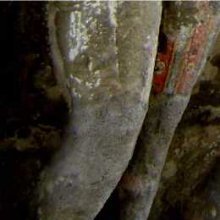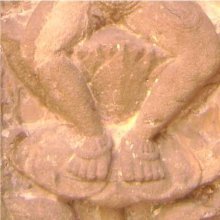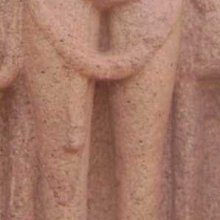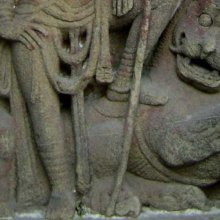Cilampu, Cilāmpu: 2 definitions
Introduction:
Cilampu means something in Hinduism, Sanskrit, Tamil. If you want to know the exact meaning, history, etymology or English translation of this term then check out the descriptions on this page. Add your comment or reference to a book if you want to contribute to this summary article.
Images (photo gallery)
In Hinduism
Natyashastra (theatrics and dramaturgy)
Source: Shodhganga: The significance of the mūla-beras (natya)Cilampu refers to a “leg ornament” which was popularly used in dance, as mentioned in the Cilappatikāram: an ancient epic authored by Ilango Adigal representing an important piece of Tamil literature.—Naṭukalkkāṭai (chapter on the sight of the statue established for Kannaki), in its twenty-eighth canto describes koṭṭicetam. With the taṇḍai (anklet) making sound, playing paṟai, the jaṭa (hairlock) swinging on one side represented Śiva while the cilampu (leg ornament), vala, hip chain, ear-drop, and hair do not move or make sound representing Uma on the other side. This dance of Śiva was danced by the Kūtta Cākkayars representing ardhanāri (half woman and half man) in front of Cheran Chenkuttuvan and his queen Venmalai while they were seated in the moon light.

Natyashastra (नाट्यशास्त्र, nāṭyaśāstra) refers to both the ancient Indian tradition (shastra) of performing arts, (natya—theatrics, drama, dance, music), as well as the name of a Sanskrit work dealing with these subjects. It also teaches the rules for composing Dramatic plays (nataka), construction and performance of Theater, and Poetic works (kavya).
Languages of India and abroad
Tamil dictionary
Source: DDSA: University of Madras: Tamil LexiconCilampu (சிலம்பு) [cilamputal] 5 intransitive verb [Malayalam: cilambu.]
1. To sound, make a tinkling noise; ஒலித்தல். சீரார் ஞெகிழஞ் சிலம்ப [olithal. sirar gnegizhagn silamba] (கலித்தொகை [kalithogai] 90).
2. To echo, ring, resound; எதிரொலித்தல். வளநகர் சிலம்பப் பாடி [ethirolithal. valanagar silambap padi] (அகநா. [agana.] 22).
--- OR ---
Cilampu (சிலம்பு) noun < சிலம்பு-. [silambu-.]
1. Sound, noise, resonance, buzz; ஒலி. (சூடாமணிநிகண்டு) [oli. (sudamaninigandu)]
2. [Malayalam: cilambu.] Tinkling anklets worn by women; மகளிர் காலணிவகை. ஒன்றின வோவவ ளஞ்சிலம் படியே [magalir kalanivagai. onrina vovava lanchilam padiye] (ஐங்குறுநூறு [aingurunuru] 389).
3. Oblong hollow ring of brass filled with pebbles and shaken before an idol in worship, etc.; பூசாரிகள் கைச்சிலம்பு. [pusarigal kaichilambu.] (W.)
4. Mountain; வைத்திய மலையகராதி நளவெண்பாியிருஞ் சிலம்பிற் சீறூர் [vaithiya malaiyagarathi naliyirugn silambir sirur] (புறநானூறு [purananuru] 143, 10).
5. Mountain slope; பக்கமலை. மால்வரைச் சிலம்பின் [pakkamalai. malvarais silambin] (பத்துப்பாட்டு: பெரும்பாணாற்றுப்படை [pathuppattu: perumbanarruppadai] 330).
6. Mountain cave, cavern; குகை. சிலம்பிற் சிலம் பிசை யோவாது [kugai. silambir silam pisai yovathu] (பரிபாடல் [paripadal] 15, 44).
--- OR ---
Cilāmpu (சிலாம்பு) noun < செறும்பு. [serumbu.] Local usage
1. Splint, splinter; சிறாம்பு. [sirambu.]
2. Scales of fish; மீன் செதிள். [min sethil.]
Tamil is an ancient language of India from the Dravidian family spoken by roughly 250 million people mainly in southern India and Sri Lanka.
See also (Relevant definitions)
Ends with: Karcilampu, Varaiccilampu.
Full-text (+7): Varaiccilampu, Karcilampu, Mauvalaram, Cilaman, Manivattam, Cilampal, Silambu, Kutaiccul, Manciram, Pariyakam, Nupuram, Calampu, Tennavan, Kannaki, Silappadikaram, Cilampan, Koncu, Conam, Patukar, Jata.
Relevant text
Search found 3 books and stories containing Cilampu, Cilāmpu, Silambu, Chilambu, Silampu, Silaambu; (plurals include: Cilampus, Cilāmpus, Silambus, Chilambus, Silampus, Silaambus). You can also click to the full overview containing English textual excerpts. Below are direct links for the most relevant articles:
Pallava period (Social and Cultural History) (by S. Krishnamurthy)
Leg Ornaments < [Chapter 4 - Material Culture of the People]
Conclusion (Material Culture) < [Chapter 5 - Conclusion]
The cultural life of the Pre-Pallava Period < [Chapter 4 - Material Culture of the People]
The Religion and Philosophy of Tevaram (Thevaram) (by M. A. Dorai Rangaswamy)
Chapter 57 - Thirukkachur Alakkoyil or Tirukkaccur (Hymn 41) < [Volume 3.5 - Pilgrim’s progress: to the North]
Chapter 4.6 - (l) Shiva’s ornamentation < [Volume 2 - Nampi Arurar and Mythology]
Chapter 4.1 - Bhikshatana-murti (the Lord becoming a beggar) < [Volume 2 - Nampi Arurar and Mythology]
Village Folk-tales of Ceylon (Sri Lanka), vol. 1-3 (by Henry Parker)
Story 21 - Nagul-munna < [Part I - Stories told by the Cultivating Caste and Vaeddas]



